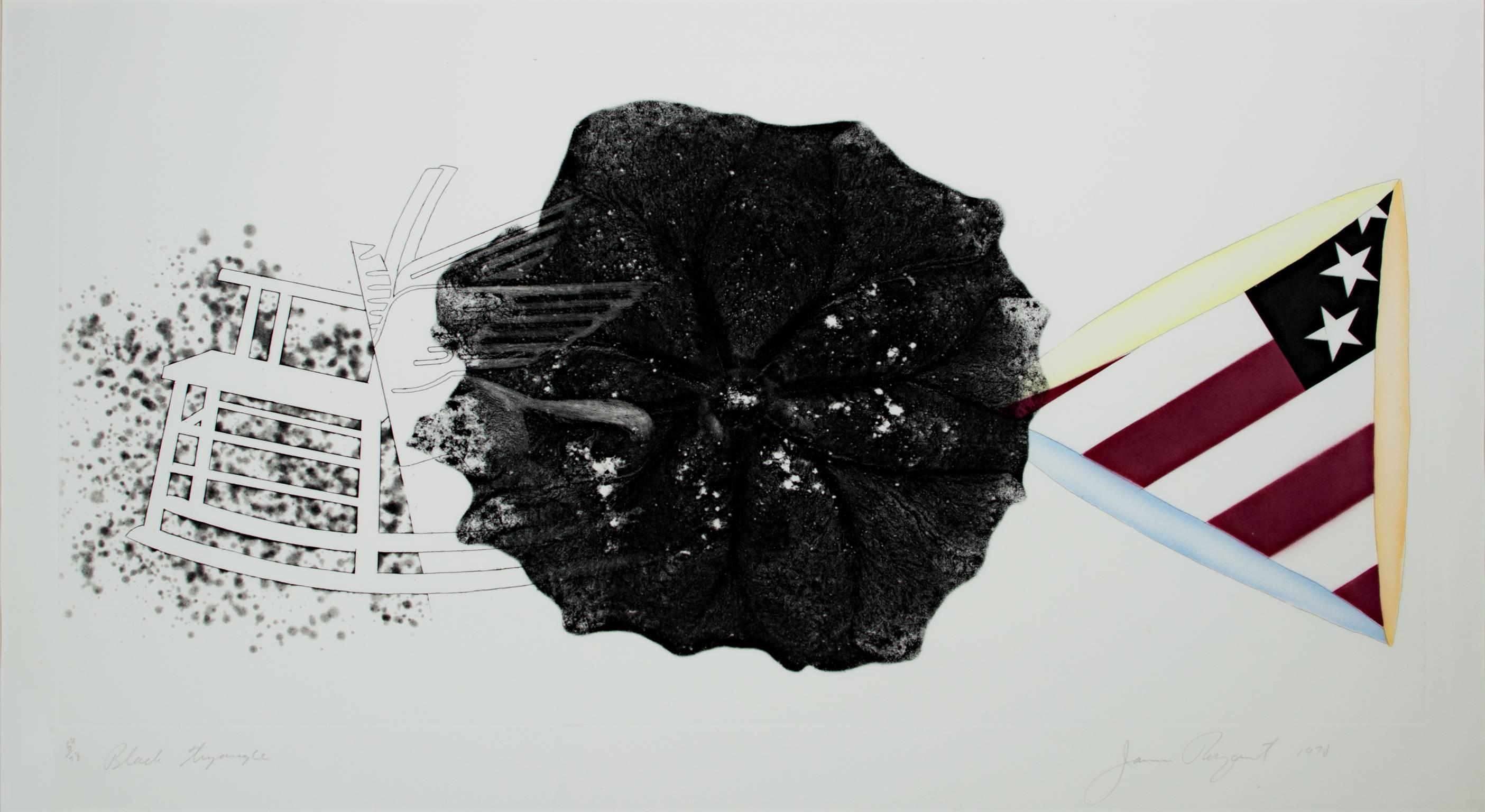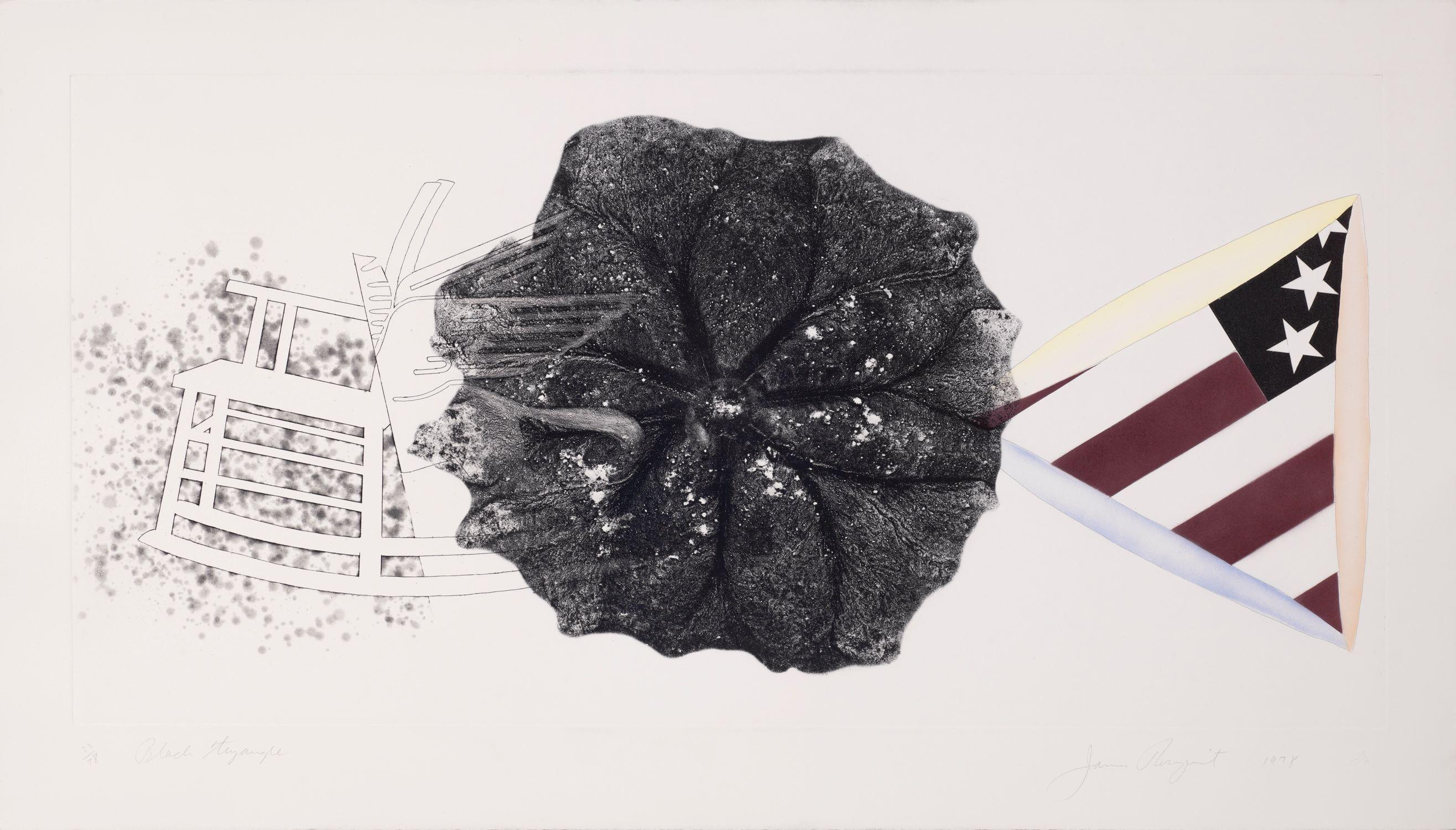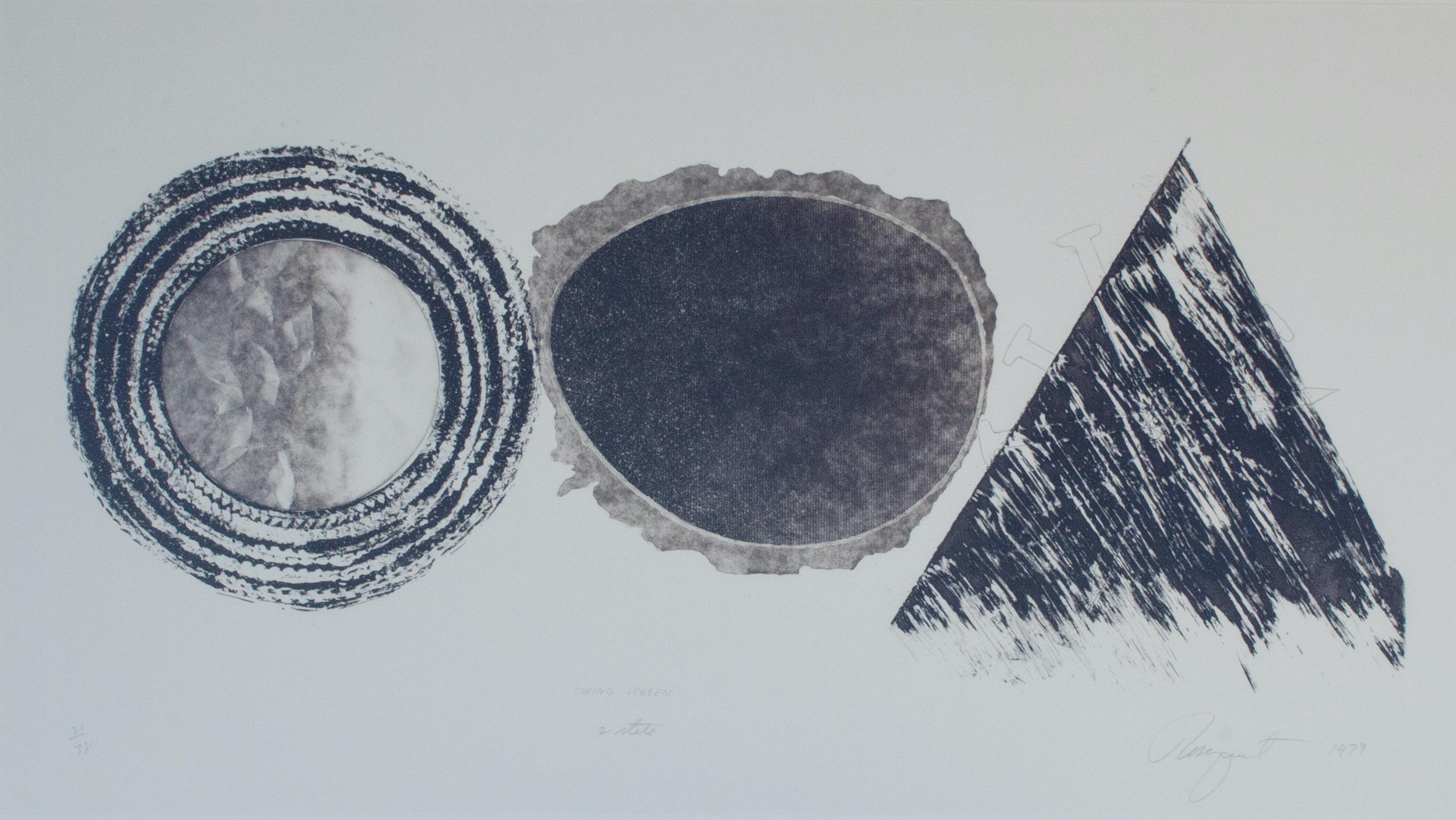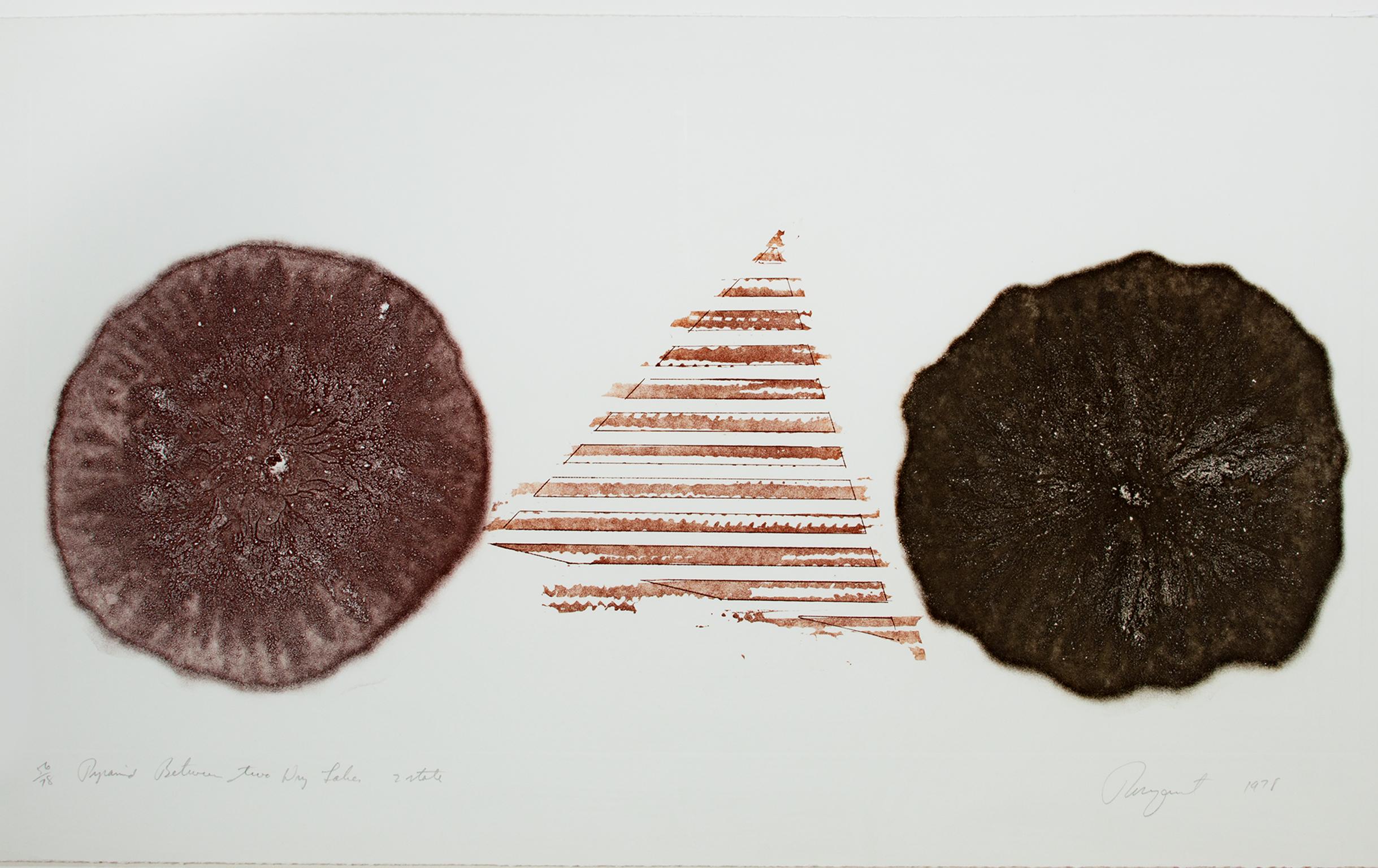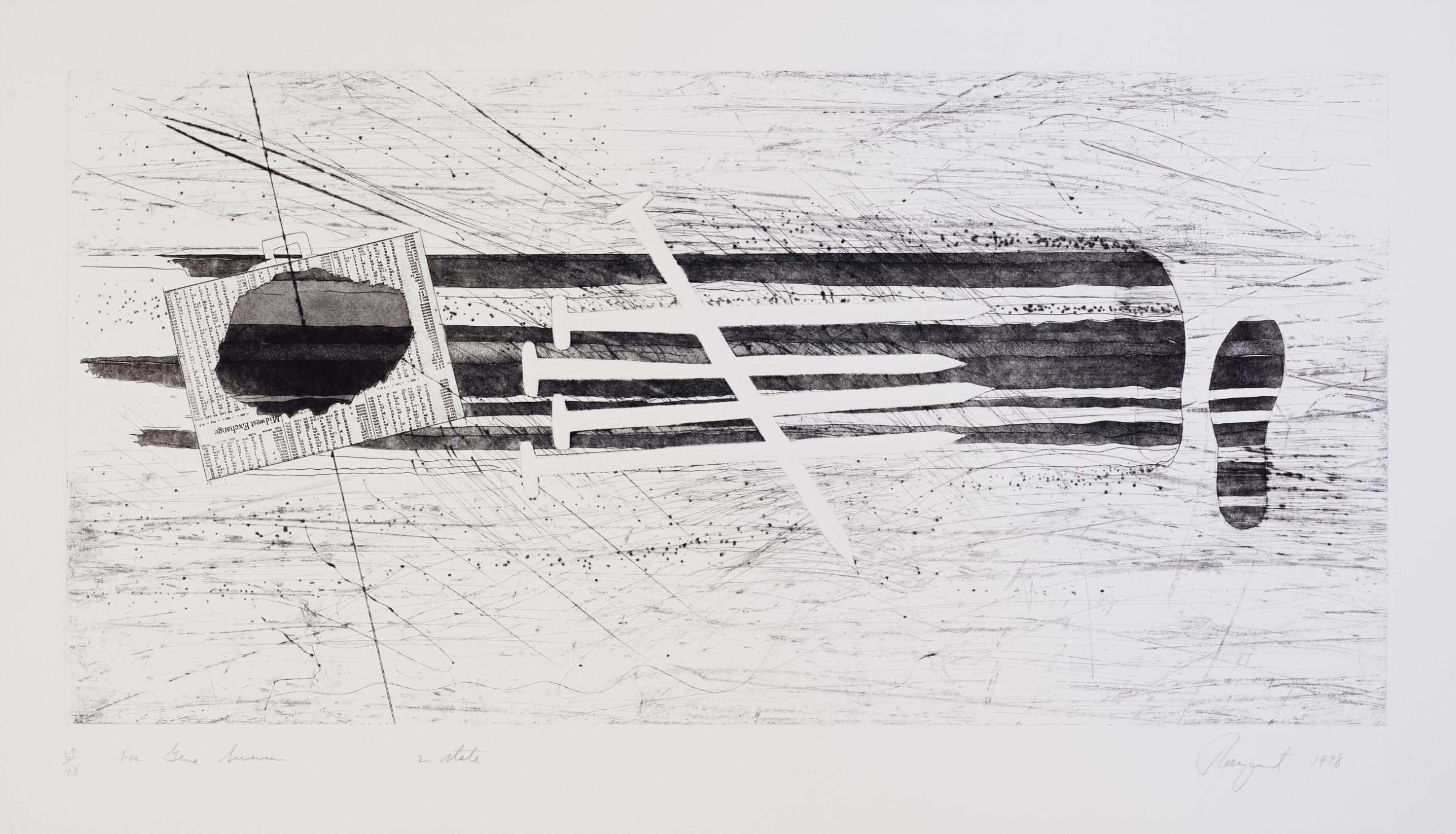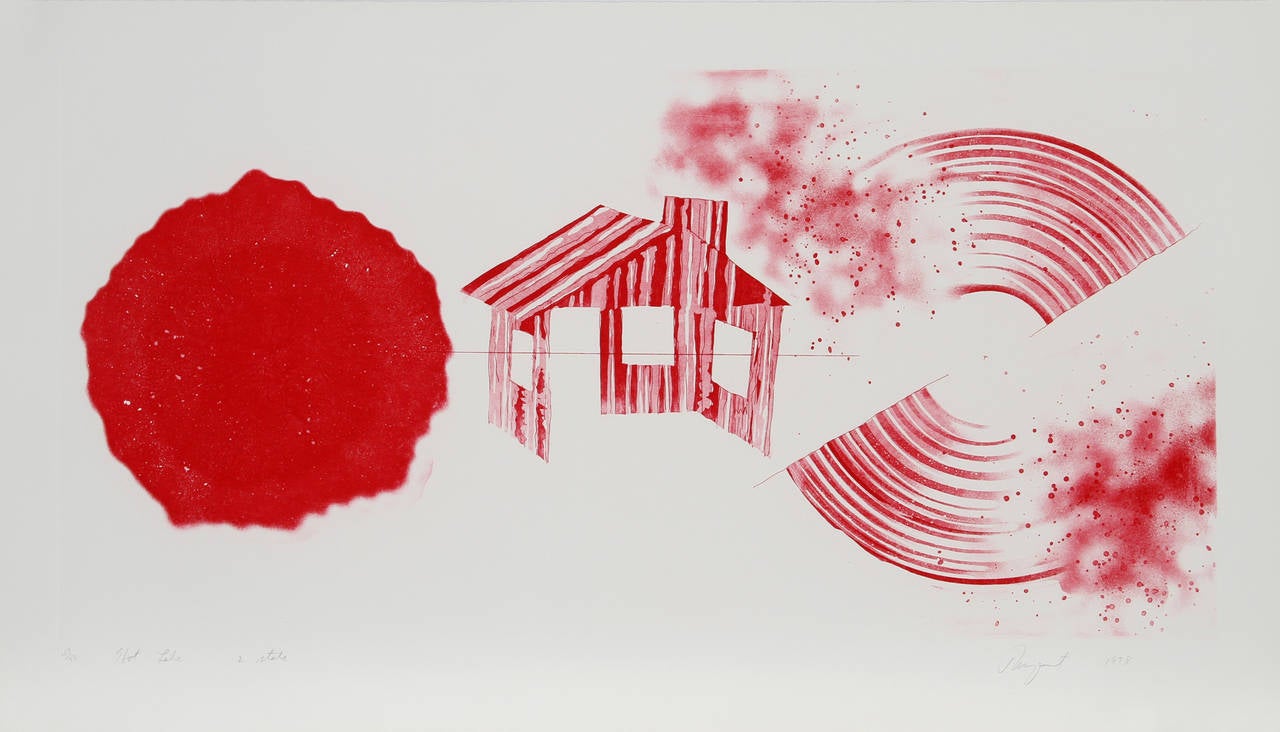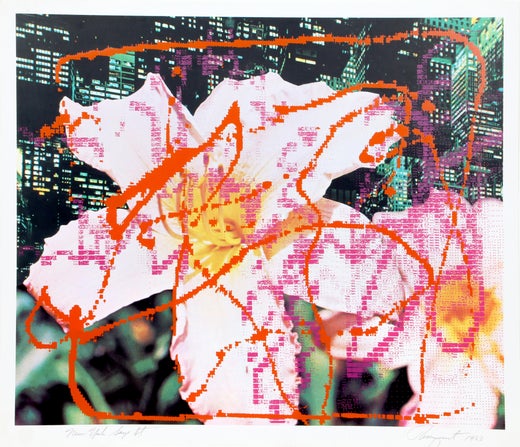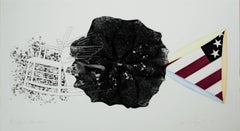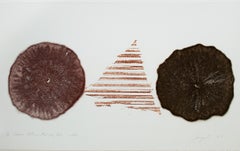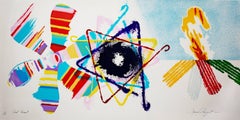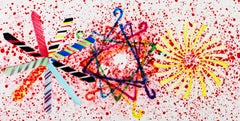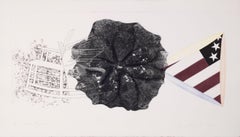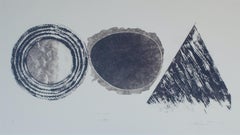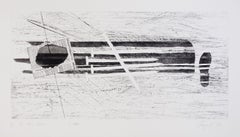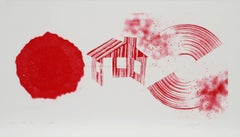"Black Triangle" is an original black etching by Pop artist James Rosenquist. The artist signed the piece lower right, wrote the title and edition number (72/78) lower left, and "2nd State" lower center. This piece is part of Rosenquist's "Tripartite" series, where he divides the composition into three juxtaposed images. This piece features a rocking chair and rocking horse, an irregular circle with a flower within, and a folded American flag (a popular icon in Pop art).
17 3/4" x 35 3/4" art
28 1/4" x 45 1/4" frame
Born in Grand Forks, North Dakota, 1933, He now lives and works in Aripeka, Florida, and New York City .Jim Rosenquist had an itinerant childhood. An only child, he moved with his family frequently throughout the Midwest. His parents shared with him their interest in airplanes and things mechanical. In junior high school Rosenquist took art classes, and he won a scholarship to attend Saturday classes at the Minneapolis School of Art. After high school he enrolled in the University of Minnesota's art program, studying with Cameron Booth. During the summer he worked for a contractor in Iowa, Wisconsin, and North Dakota, painting signs and bulk storage tanks.
In 1954 Rosenquist painted his first billboard for General Outdoor Advertising in Minneapolis. A year later, on scholarship to the Art Students League in New York, Rosenquist studied with Edwin Dickinson, Will Barnet, Morris Kantor, George Grosz, and Vaclav Vytacil. In 1957 Rosenquist joined the sign painters union and in 1958 went to work for Art Kraft Strauss Company painting billboards. He also worked on window displays for Bonwit Teller and Tiffany & Company.
He married the textile designer Mary Lou Adams. During the election he produced the picture President Elect in which John F. Kennedy's face is combined in a kind of collage with sex and automobile imagery. His first one-man exhibition in the Green Gallery, in 1962, was sold out. In 1963 he worked on several sculptures, had a number of exhibitions at the Galerie Ileana Sonnabend, showed his work at the Dwan Gallery, Los Angeles, and taught at Yale University. In 1965 he began to work with lithographs.
In the same year he made the 26 meter-wide picture F-111, which was shown at the Jewish Museum, New York, at Moderna Museet, Stockholm, and in other European cities. It is one of his most important works. The spatial organization of the composition into layers suggests the interrelationship of contemporary historical symbols and signs of affluence and military hardware, a vision of American culture expressing the proximity of euphoria and catastrophe. In 1967 he moved to East Hampton.
In 1968 he was given his first retrospective by the National Gallery of Canada, Ottawa. In 1969 he turned his attention to experimenting with film techniques. In 1970 he went to Cologne for the opening of his exhibition at the Galerie Rolf Ricke. During the public protest against the Vietnam War he was briefly detained in Washington. During the same year he had comprehensive retrospectives at the Wallraf-Richards Museum, Cologne, and the Whitney Museum, New York.
In 1974 and 1975, he lobbied the U.S. Senate on the legal rights of artists. He became separated from his wife and designed his own house with an open-air studio at Indian Bay, Aripeka, Florida. In 1978 F-111 was exhibited in the International Pavilion at the Venice Biennale. In his work of the late seventies and eighties, e.g. 4 "New Clear Women," images of women are confronted with machine aesthetics, usually in large oblong compositions. The themes of these dynamic compositions also include fire, progress and war machinery which he shows in rotating pictorial narratives. Between 1985 and 1987 Rosenquist's entire development as an artist was shown in a comprehensive retrospective at six American museums.
By 1960 Rosenquist had set aside enough of his commercial earnings to allow him to spend a year painting in his studio. He moved to Coentles Slip, where he shared a loft with Charles Hinman. Rosenquist had tentatively explored the use of commercial methods and materials in his studio work of the late 1950s, but after his move to the Slip, he left behind both the abstract expressionist and figurative modes he had employed in his early work. He developed the montage like arrangement of deliberately fragmented images from popular culture inconsistently scaled and enigmatically juxtaposed; that characterized the monumental paintings of his mature style.
Rosenquist had his first one-man exhibition at the Green Gallery in New York in 1962, and every painting was sold. In 1963 he completed a mural for the New York World's Fair, and Art in, America selected him as "Young Talent Painter" of the year. Two years later the artist finished painting the monumental, highly publicized F- I I 1, which toured Europe during the 1960s and has been considered an important expression of the anti Vietnam War movement. During the 1970s he became active in issues of artists' rights legislation. In 1976 Rosenquist built his house and studio in Aripeka, Florida.
Since the early 1960s Rosenquist has worked extensively at numerous printmaking workshops in addition to Graphic studio, including Aeropress, Gemini G.E.L., Petersburg Press, Styria Studios, Tyler Graphics, Ltd., and Universal Limited Art Editions. Among Rosenquist's honors is the World Print Award, which he received in 1983 from the World Print Council at the San Francisco Museum of Modem Art.
In 2003 the Solomon R. Guggenheim Museum in New York had a retrospective of Rosenquist works starting in 1950. In 2004 the exhibition goes to Spain's Guggenheim Bilbao.Born in Grand Forks, North Dakota, 1933, He now lives and works in Aripeka, Florida, and New York City .Jim Rosenquist had an itinerant childhood. An only child, he moved with his family frequently throughout the Midwest. His parents shared with him their interest in airplanes and things mechanical. In junior high school Rosenquist took art classes, and he won a scholarship to attend Saturday classes at the Minneapolis School of Art. After high school he enrolled in the University of Minnesota's art program, studying with Cameron Booth. During the summer he worked for a contractor in Iowa, Wisconsin, and North Dakota, painting signs and bulk storage tanks.
In 1954 Rosenquist painted his first billboard for General Outdoor Advertising in Minneapolis. A year later, on scholarship to the Art Students League in New York, Rosenquist studied with Edwin Dickinson, Will Barnet, Morris Kantor, George Grosz, and Vaclav Vytacil. In 1957 Rosenquist joined the sign painters union and in 1958 went to work for Art Kraft Strauss Company painting billboards. He also worked on window displays for Bonwit Teller and Tiffany & Company.
He married the textile designer Mary Lou Adams. During the election he produced the picture President Elect in which John F. Kennedy's face is combined in a kind of collage with sex and automobile imagery. His first one-man exhibition in the Green Gallery, in 1962, was sold out. In 1963 he worked on several sculptures, had a number of exhibitions at the Galerie Ileana Sonnabend, showed his work at the Dwan Gallery, Los Angeles, and taught at Yale University. In 1965 he began to work with lithographs.
In the same year he made the 26 meter-wide picture F-111, which was shown at the Jewish Museum, New York, at Moderna Museet, Stockholm, and in other European cities. It is one of his most important works. The spatial organization of the composition into layers suggests the interrelationship of contemporary historical symbols and signs of affluence and military hardware, a vision of American culture expressing the proximity of euphoria and catastrophe. In 1967 he moved to East Hampton.
In 1968 he was given his first retrospective by the National Gallery of Canada, Ottawa. In 1969 he turned his attention to experimenting with film techniques. In 1970 he went to Cologne for the opening of his exhibition at the Galerie Rolf Ricke. During the public protest against the Vietnam War he was briefly detained in Washington. During the same year he had comprehensive retrospectives at the Wallraf-Richards Museum, Cologne, and the Whitney Museum, New York.
In 1974 and 1975, he lobbied the U.S. Senate on the legal rights of artists. He became separated from his wife and designed his own house with an open-air studio at Indian Bay, Aripeka, Florida. In 1978 F-111 was exhibited in the International Pavilion at the Venice Biennale. In his work of the late seventies and eighties, e.g. 4 "New Clear Women," images of women are confronted with machine aesthetics, usually in large oblong compositions. The themes of these dynamic compositions also include fire, progress and war machinery which he shows in rotating pictorial narratives. Between 1985 and 1987 Rosenquist's entire development as an artist was shown in a comprehensive retrospective at six American museums.
By 1960 Rosenquist had set aside enough of his commercial earnings to allow him to spend a year painting in his studio. He moved to Coentles Slip, where he shared a loft with Charles Hinman. Rosenquist had tentatively explored the use of commercial methods and materials in his studio work of the late 1950s, but after his move to the Slip, he left behind both the abstract expressionist and figurative modes he had employed in his early work. He developed the montage like arrangement of deliberately fragmented images from popular culture inconsistently scaled and enigmatically juxtaposed; that characterized the monumental paintings of his mature style.
Rosenquist had his first one-man exhibition at the Green Gallery in New York in 1962, and every painting was sold. In 1963 he completed a mural for the New York World's Fair, and Art in, America selected him as "Young Talent Painter" of the year. Two years later the artist finished painting the monumental, highly publicized F- I I 1, which toured Europe during the 1960s and has been considered an important expression of the anti Vietnam War movement. During the 1970s he became active in issues of artists' rights legislation. In 1976 Rosenquist built his house and studio in Aripeka, Florida.
Since the early 1960s Rosenquist has worked extensively at numerous printmaking workshops in addition to Graphic studio, including Aeropress, Gemini G.E.L., Petersburg Press, Styria Studios, Tyler Graphics, Ltd., and Universal Limited Art Editions. Among Rosenquist's honors is the World Print Award, which he received in 1983 from the World Print Council at the San Francisco Museum of Modem Art.
In 2003 the Solomon R. Guggenheim Museum in New York had a retrospective of Rosenquist works starting in 1950. In 2004 the exhibition goes to Spain's Guggenheim Bilbao.
